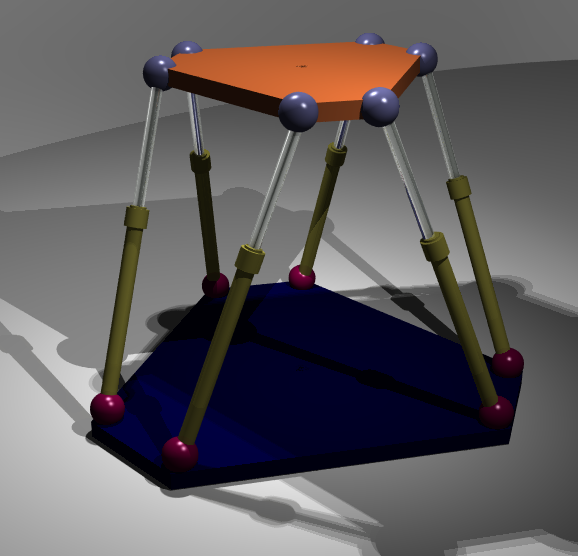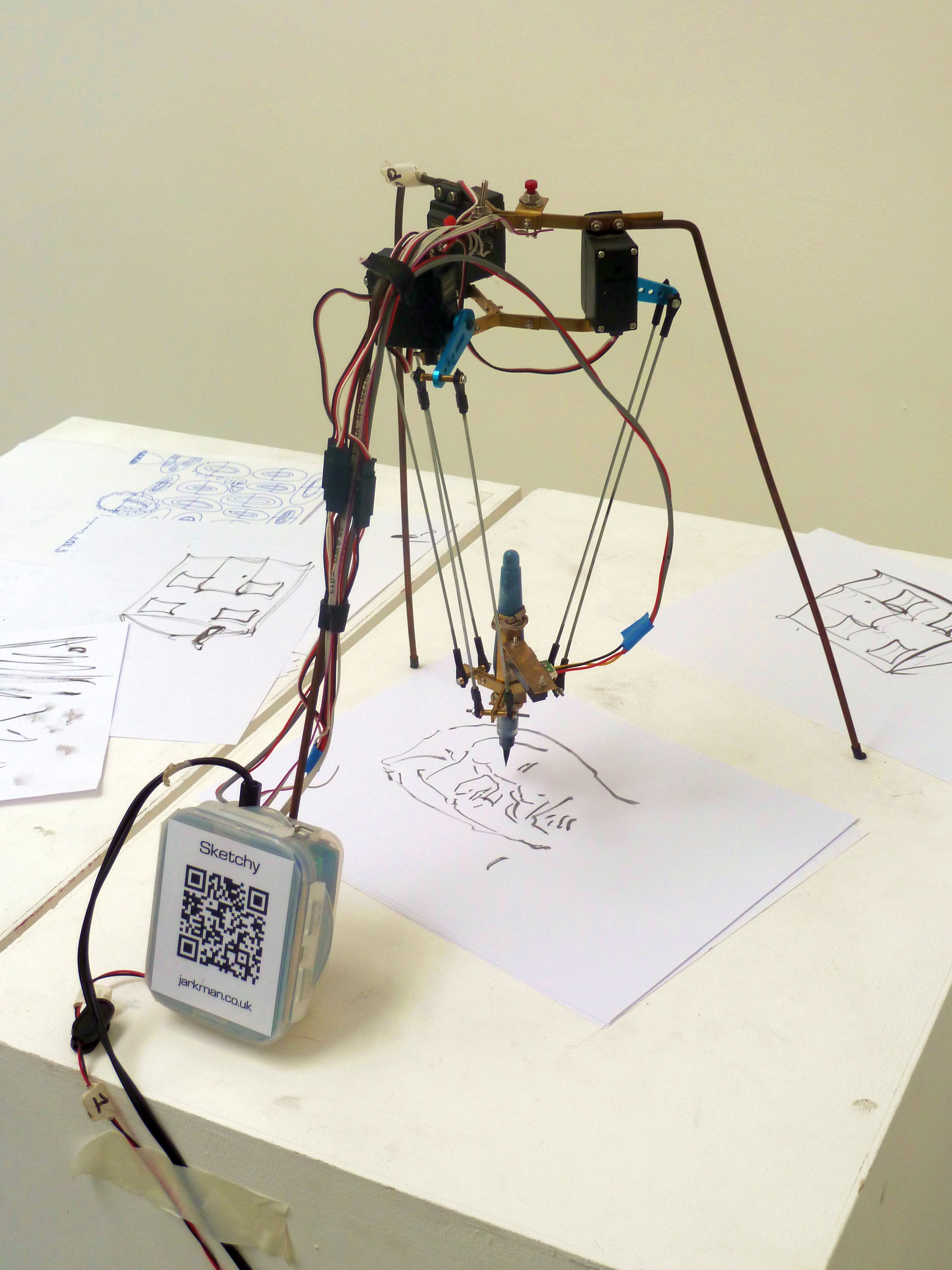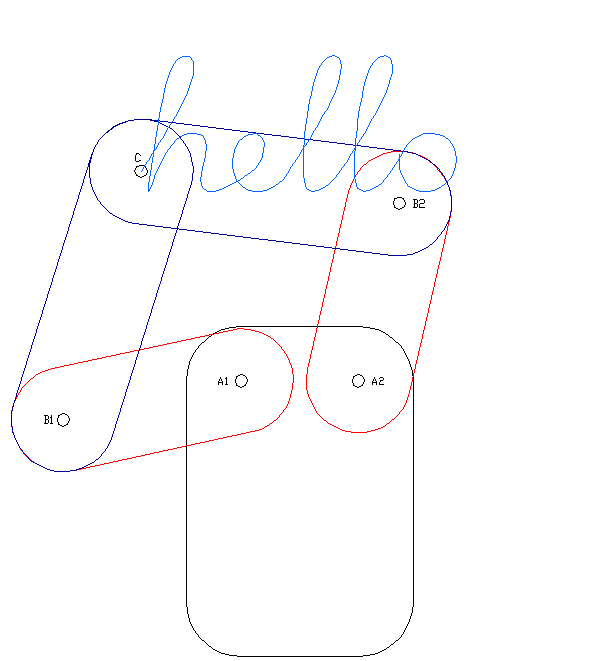|
Schoenflies Displacement
Schoenflies (or Schönflies) displacement (or motion) named after Arthur Moritz Schoenflies is a rigid body motion consisting of linear motion in three dimensional space plus one orientation around an axis with fixed direction. In robotic manipulation this is a common motion as many pick and place operations require moving an object from one plane and placing it with a different orientation onto another parallel plane (''e.g.'', placement of components on a circuit board). These robots are commonly called Schoenflies-motion generators. Because the SCARA manipulator was one of the first manipulators providing similar motion, this is often referred to as SCARA-type motion. Today, many robotic manipulators, including some with parallel kinematic architecture, are used in industry for applications ranging from the manufacture of electronics to food processing and packaging industry. See also * Articulated robot * Parallel manipulator * SCARA * Delta robot A delta robot is a type ... [...More Info...] [...Related Items...] OR: [Wikipedia] [Google] [Baidu] |
Arthur Moritz Schoenflies
Arthur Moritz Schoenflies (; 17 April 1853 – 27 May 1928), sometimes written as Schönflies, was a German mathematician, known for his contributions to the application of group theory to crystallography, and for work in topology. Schoenflies was born in Landsberg an der Warthe (modern Gorzów, Poland). Arthur Schoenflies married Emma Levin (1868–1939) in 1896. He studied under Ernst Kummer and Karl Weierstrass, and was influenced by Felix Klein. The Schoenflies problem is to prove that an (n - 1)-sphere in Euclidean ''n''-space bounds a topological ball, however embedded. This question is much more subtle than it initially appears. He studied at the University of Berlin from 1870 to 1875. He obtained a doctorate in 1877, and in 1878 he was a teacher at a school in Berlin. In 1880, he went to Colmar to teach. Schoenflies was a frequent contributor to Klein's encyclopedia: In 1898 he wrote on set theory, in 1902 on kinematics, and on projective geometry in 1910. He was ... [...More Info...] [...Related Items...] OR: [Wikipedia] [Google] [Baidu] |
SMT Placement Equipment
Surface-mount technology (SMT) component placement systems, commonly called pick-and-place machines or P&Ps, are robotic machines which are used to place surface-mount devices (SMDs) onto a printed circuit board (PCB). They are used for high speed, high precision placing of a broad range of electronic components, like capacitors, resistors, integrated circuits onto the PCBs which are in turn used in computers, consumer electronics as well as industrial, medical, automotive, military and telecommunications equipment. Similar equipment exists for through-hole components. This type of equipment is sometimes also used to package microchips using the flip chip method. History 1980s and 1990s During this time, a typical SMT assembly line employed two different types of pick-and-place (P&P) machines arranged in sequence. The unpopulated board was fed into a rapid placement machine. These machines, sometimes called chip shooters, place mainly low-precision, simple package compone ... [...More Info...] [...Related Items...] OR: [Wikipedia] [Google] [Baidu] |
SCARA
The SCARA is a type of industrial robot. The acronym stands for Selective Compliance Assembly Robot Arm or Selective Compliance Articulated Robot Arm. By virtue of the SCARA's parallel-axis joint layout, the arm is slightly compliant in the X-Y direction but rigid in the Z direction, hence the term ''selective compliance''. This is advantageous for many types of assembly operations, for example, inserting a round pin in a round hole without binding. The second attribute of the SCARA is the jointed two-link arm layout similar to human arms, hence the often-used term, ''articulated''. This feature allows the arm to extend into confined areas and then retract or "fold up" out of the way. This is advantageous for transferring parts from one cell to another or for loading or unloading process stations that are enclosed. SCARAs are generally faster than comparable Cartesian robot systems. Their single pedestal mount requires a small footprint and provides an easy, unhindered form ... [...More Info...] [...Related Items...] OR: [Wikipedia] [Google] [Baidu] |
Manipulator (device)
In robotics, a manipulator is a device used to manipulate materials without direct physical contact by the operator (profession), operator. The applications were originally for dealing with ionizing radiation, radioactive or biohazardous materials, using robotic arms, or they were used in inaccessible places. In more recent developments they have been used in diverse range of applications including welding automation, robotic surgery and in robotic arm, space. It is an arm-like mechanism that consists of a series of segments, usually sliding or jointed called cross-slides, which grasp and move objects with a number of degrees of freedom (mechanics), degrees of freedom. In industrial ergonomics a manipulator is a lift-assist device used to help workers lift, maneuver and place articles in process that are too heavy, too hot, too large or otherwise too difficult for a single worker to manually handle. As opposed to simply vertical lift assists (cranes, hoists, etc.) manipulators ... [...More Info...] [...Related Items...] OR: [Wikipedia] [Google] [Baidu] |
Parallel Manipulator
A parallel manipulator is a mechanical system that uses several computer-controlled serial chains to support a single platform, or end-effector. Perhaps, the best known parallel manipulator is formed from six linear actuators that support a movable base for devices such as flight simulators. This device is called a Stewart platform or the Gough-Stewart platform in recognition of the engineers who first designed and used them. Also known as parallel robots, or generalized Stewart platforms (in the Stewart platform, the actuators are paired together on both the basis and the platform), these systems are articulated robots that use similar mechanisms for the movement of either the robot on its base, or one or more manipulator arms. Their 'parallel' distinction, as opposed to a serial manipulator, is that the end effector (or 'hand') of this linkage (or 'arm') is directly connected to its base by a number of (usually three or six) separate and independent linkages working simu ... [...More Info...] [...Related Items...] OR: [Wikipedia] [Google] [Baidu] |
Articulated Robot
An articulated robot is a robot with rotary joints (e.g. a legged robot or an industrial robot). Articulated robots can range from simple two-jointed structures to systems with 10 or more interacting joints and materials. They are powered by a variety of means, including electric motors. Some types of robots, such as robotic arms, can be articulated or non-articulated. http://www.ssl.umd.edu/projects/rangertsx/data/spacerobotics-UNDSPST470.pdf , pg 9 Articulated robots in action Image:Factory Automation Robotics Palettizing Bread.jpg, Robots palletizing food (Bakery) Image: Robotics Cutting Bridge Building Parts.jpg, Manufacturing of steel bridges, cutting steel Image:KUKA robot for flat glas handling.jpg, Flat-glass handling, heavy duty robot with 500 kg payload Image:Automation of foundry with robot.jpg, Automation in foundry industry, heat resistant robot Image:Robotworx-spot-welding-robot.jpg, Spot Welding Robot Definitions Articulated Robot: See Figure. An articu ... [...More Info...] [...Related Items...] OR: [Wikipedia] [Google] [Baidu] |
Delta Robot
A delta robot is a type of parallel robot that consists of three arms connected to universal joints at the base. The key design feature is the use of parallelograms in the arms, which maintains the orientation of the end effector. In contrast, Stewart platform can change the orientation of its end effector.Bonev, I. The True Origins of Parallel Robots. Online article available at http://www.parallemic.org/Reviews/Review007.html Delta robots have popular usage in picking and packaging in factories because they can be quite fast, some executing up to 300 picks per minute. History The delta robot (a parallel arm robot) was invented in the early 1980s by a research team led by professor Reymond Clavel at the École Polytechnique Fédérale de Lausanne (EPFL, Switzerland). After a visit to a chocolate maker, a team member wanted to develop a robot to place pralines in their packages. The purpose of this new type of robot was to manipulate light and small objects at a very high s ... [...More Info...] [...Related Items...] OR: [Wikipedia] [Google] [Baidu] |
Industrial Robots
An industrial robot is a robot system used for manufacturing. Industrial robots are automated, programmable and capable of movement on three or more axes. Typical applications of robots include welding, painting, assembly, disassembly, pick and place for printed circuit boards, packaging and labeling, palletizing, product inspection, and testing; all accomplished with high endurance, speed, and precision. They can assist in material handling. In the year 2020, an estimated 1.64 million industrial robots were in operation worldwide according to International Federation of Robotics (IFR). Types and features There are six types of industrial robots. Articulated robots Articulated robots are the most common industrial robots. They look like a human arm, which is why they are also called robotic arm or manipulator arm. Their articulations with several degrees of freedom allow the articulated arms a wide range of movements. Cartesian coordinate robots Cartesian robots ... [...More Info...] [...Related Items...] OR: [Wikipedia] [Google] [Baidu] |
Robot Kinematics
In robotics, robot kinematics applies geometry to the study of the movement of multi-degree of freedom kinematic chains that form the structure of robotic systems. The emphasis on geometry means that the links of the robot are modeled as rigid bodies and its joints are assumed to provide pure rotation or translation. Robot kinematics studies the relationship between the dimensions and connectivity of kinematic chains and the position, velocity and acceleration of each of the links in the robotic system, in order to plan and control movement and to compute actuator forces and torques. The relationship between mass and inertia properties, motion, and the associated forces and torques is studied as part of robot dynamics. Kinematic equations A fundamental tool in robot kinematics is the kinematics equations of the kinematic chains that form the robot. These non-linear equations are used to map the joint parameters to the configuration of the robot system. Kinematics equatio ... [...More Info...] [...Related Items...] OR: [Wikipedia] [Google] [Baidu] |






